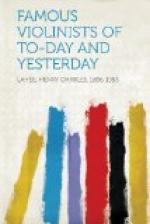He is described as a man of commonplace appearance, with dull, expressionless eyes, sluggish movements, and slow, affected manner of speech. His technique is not astonishing, but he has a full, penetrating, sympathetic tone. There is no charlatanism or trickery in his playing, nor any virtuoso effects, but the charm of it rests in his glowing temperament, ideal conception, and wonderful power of expression. He has been regarded as phenomenal, because he can move the hearts of his hearers as few other violinists are able to do.
Petschnikoff has been given an introduction to America, through Mr. Emil Paur, by Theodor Leschetizky, couched in the most glowing terms, and is called by him “an artist of the very first rank and of inconceivable versatility.”
One might prolong the list of violinists to a tremendous extent, and yet fail to mention all those of great merit. In England, John Dunn appears to be acquiring a great reputation. On the Continent, such names as Hubay, Petri, Rose are well known. In America, we have Leopold Lichtenberg, a good musician of admirable qualifications. Bernhard Listemann, now of Chicago, has done much toward forming musical taste in America, and was concert-master of the Boston Symphony Orchestra during the first few years of its existence. But space does not permit of a mention of more than has been attempted, and a few pages must be given to lady violinists and to a few words about celebrated quartets.
CHAPTER X.
WOMEN AS VIOLINISTS.
During the past forty or fifty years the violin has become a fashionable instrument for ladies, and has become correspondingly popular as a profession for those who are obliged to earn a living.
Formerly, for many years, it seems to have been considered improper, or ungraceful, or unladylike,—the reasons are nowhere satisfactorily given, but the fact remains that until recently few women played the violin.
From the year 1610 until 1810 the list of those who played in public is extremely short, numbering only about twenty, and of these several were gambists.
That women did, once upon a time, play on the violin, or the corresponding string and bow instruments which were its ancestors, there is evidence.
On the painted roof of Peterborough Cathedral, in England, which is said to have been built in the year 1194 A.D., there is a picture of a woman seated, and holding in her lap a sort of viol, with four strings and four sound-holes. This seems to indicate that in very early days ladies sometimes played on stringed instruments, if only for their own amusement.
Among the accounts of King Henry VII., dated November 2, 1495, is the following item, “For a womane that singeth with a fiddle, 2 shillings.”
Anne of Cleves after her divorce comforted herself by playing on a viol with six strings. Queen Elizabeth, also, amused herself not only with the lute, the virginals, and her voice, but also with the violin.




